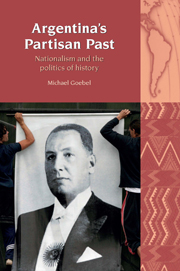Book contents
- Frontmatter
- Contents
- Acknowledgements
- List of acronyms and abbreviations
- Introduction
- 1 Argentina's two pantheons: from mitrismo to revisionism
- 2 Between co-optation and opposition: Peronism, nationalism and the politics of history, 1943–55
- 3 The deepening polarisation: the proscription of Peronism and its politics of history, 1955–66
- 4 The apogee of revisionism: nationalism, political violence and the politics of history, 1966–76
- 5 New narratives for a new era? Shifts, decline and resurgence of nationalist constructions of the past since 1976
- Conclusion
- Glossary
- Bibliography
- Index
1 - Argentina's two pantheons: from mitrismo to revisionism
- Frontmatter
- Contents
- Acknowledgements
- List of acronyms and abbreviations
- Introduction
- 1 Argentina's two pantheons: from mitrismo to revisionism
- 2 Between co-optation and opposition: Peronism, nationalism and the politics of history, 1943–55
- 3 The deepening polarisation: the proscription of Peronism and its politics of history, 1955–66
- 4 The apogee of revisionism: nationalism, political violence and the politics of history, 1966–76
- 5 New narratives for a new era? Shifts, decline and resurgence of nationalist constructions of the past since 1976
- Conclusion
- Glossary
- Bibliography
- Index
Summary
Introduction
Nationalists tend to portray their nation as an indivisible whole, anchored in a common origin. Correspondingly, many nationalist accounts of history gloss over past fratricides and point towards a shared future. From a nationalist point of view, too corrosive a historiography may appear to threaten the foundations of an agreeable national identity. The French conservative thinker Ernest Renan famously argued in 1882 that his compatriots should leave behind the divisions of the past and forget the Massacre of St Bartholomew's Day because ‘to forget and […] to get one's history wrong, are essential factors in the making of a nation; and thus the advance of historical studies is often a danger to nationality’. As Craig Calhoun has observed, the dominant strands of nationalist historiography in countries as different as India and the United States have obeyed this maxim of downplaying rivalries and strife between groups belonging to the same nationality. Such an approach to the nation's history would correspond to a type of nationalism primarily intent on diluting internal political, cultural or ethnic antagonisms, either in opposition to an external enemy or in an attempt to defuse crises emanating from internal conflict. This form of nationalism is therefore designed to legitimise power and, as a consequence, most likely to be favoured by the state.
However, nationalism can also be mobilised against the holders of power. Typical cases are ‘national’ groups that see themselves as oppressed by a central government, which they denounce as an occupying force from outside.
- Type
- Chapter
- Information
- Argentina's Partisan PastNationalism and the Politics of History, pp. 23 - 64Publisher: Liverpool University PressPrint publication year: 2011

